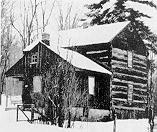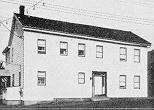
|

|

Charles Butler home was built in Elk Lick Township, south of Salisbury, in the early 1800's. Currently owned by Fred Showalter. |

|

|

|

Charles Butler home was built in Elk Lick Township, south of Salisbury, in the early 1800's. Currently owned by Fred Showalter. |

|

ITALIANATE 1840-1885
In 1842, American landscape architect Andrew Jackson Downing
published a pattern book for building houses entitled Cottage
Residences which offered full-facade drawings of several new fashions
as alternatives to the Greek Revival style. The most popular of these
designs became the Italianate based on Northern Italian villas and
farmhouses. The Italianate style house is usually 2-3 stories high with
a
low-pitched roof and overhanging eaves. The windows are tall and
narrow, sometimes curved at the top and decorated with elaborate
crowns. Some other Italianate features: entry or full-width porches with
beveled roof support columns; paired entrance doors, often matching
the design of the windows; wide cornices below the roofs, usually
featuring elaborate wooden brackets; bold window frames, sometimes
arranged in pairs or multiples. The Italianate style continued strong in
America until the depression following the financial panic of 1873,
when most new house construction came to a stop. When construction
resumed, new styles were coming into vogue.
SECOND EMPIRE 1855-1885
The Second Empire style reflects the design adopted by Austrian
engineer Baron Georges Eugene Haussmann for the rebuilding of Paris
during the reign of Napoleon III (1852-70). The Paris Expositions of
1855 and 1867 helped to popularize the style with visiting architects
from England and America. The new mansard roof (named for the 17th
century French architect Francois Mansart) was considered an important
advance because it provided a full upper story of usable space. At the
top and bottom of the steeply sloping roof usually are matching
cornices to tie the roof area together visually. Dormer windows with
decorative framing punctuate the roof. Some Second Empire houses also
have one-story porches and bay windows, and may have arched
windows and paired doors similar to the Italianate style. The most
prominent public building built in the Second Empire style is the former
War Department building in Washington, D.C., now the Old Executive
Office Building.
QUEEN ANNE 1870-1910
To a large extent, the sudden appearance and popularity of the Queen
Anne style was a result of railroads and the new industrial age which
made it possible to ship pre-cut spindlework porch railings, porch
support brackets and other architectural details to builders in small
towns across America. The style was popularized in England by a 19th
century architect named Richard Norman Shaw who revived the use of
half-timbered and patterned masonry building styles from the late
Medieval period and named the new fashion for Queen Anne (who
reigned from 1702 to 1714). American adaptations were spread rapidly
by the country's first architectural magazine, The American Architect and
Building News, which encouraged the use of spindlework decoration.
The main characteristic of the Queen Anne style is in the building shape,
which is usually not square and has a high steep roof of irregular shape,
often with one dominant gable facing the front of the structure. The style
also uses wall surfaces as primary decorative elements, often employing
patterned shingles. Another Queen Anne characteristic is an
asymmetrical one-story porch that extends along one or both side walls.
The variations in Queen Anne style are many, and its popularity
continued until the turn of the century, often in large mansions built for
prosperous financiers and industrialists the architectural Gilded Age.
Greek Revival - These are most typical in the South.
They have pillars or columns on the front which usually
hold up a balcony on the second floor. The front has
some typed of porch or portico that is enclosed in pillars or
columns. they tend to be somewhat symmetrical. The white
ones look very much like ancient Greek temples with
pillars all the way across the front, especially if they have a gently sloped
roof.
Gothic - This style comes from medieval English
castles, and was considered to be the proper style for churches
and other public buildings. Some of the characteristics
are pointed arched windows, gables, trefoils (three-pronged
shapes), rich tracery-intricate designs, gingerbread
trim, very ornate intricately designed and detailed trim that
sometimes is almost overdone and bordering on ugly.
If the trim was gone, the house would be very plain with simple angles.
A lot of old farm houses were done in the style. Also in this
style are the stereotypical white country chapels.
Italiante - The earlier houses in this style were
the more villa like houses which were detached or semi-detached
urban residences with yard and garden space, soaring
off-center towers, loggia porch-like areas walled in by arches.
Later on, boxier, simpler profiles became more common.
Both have an asymmetrical arrangement of windows and doors,
low-pitched roofs, round openings, deep bracketed eaves, with or without
mansard roofs
(roofs that curve or angle sharply up to a flat top), and with bricks, stucco,
or wood siding.
French - this style is usually a tall, narrow house.
They have symmetrical proportions, with or without a mansard
roof, a two or three story tower in front. This is mostly
an urban design which is good for lots that are narrow and have
limited space and light. this style is a painter's
nightmare with all of the elaborate window framing, paneled frieze
boards under a bracketed cornice (paneled trim under
a bracketed roof), roof trim, gingerbread, and are very ornate and
fancy.
Stick Style - This is usually associated with summer
homes, but there are some regular houses with this style.
They are a rambling, asymmetrical concoction of large
verandahs, projecting towers, and bay windows. They have
exaggerated structural detailing, and are very individualistic
and you see a little bit of everything. The are designed to
relate to the outdoors and are informal and have a peaceful,
tranquil, homey persona.
Queen Anne - This style has some Gothic design in
it but is more extravagant than Gothic. They have off-center
turrets and towers, both shingling and clapboarding
on the sides, a mixture of carved and relief decoration, and wrap
around porches. Many people who don't know that there
are many different Victorian styles, think of only this type of
house to be the classic Victorian design.
Renaissance Revival - This is a nearly seamless
box of a townhouse, usually made of brick or stone and
kind of drab. this type doesn't have much trim and was
probably only popular because only the rich could afford to
build a house like this. They tended to be in sophisticated
cities where the rich people would live.
Colonial - These are very symmetrical and the doors
and windows are equally spaced. They have a flat, boxy
profile and have various assortments of lunettes (semi-circle
shaped windows), porticos which are smaller than those
typical of Greek, but are still fairly good sized,
summer porches that might be screened in, porte-cocheres (an open
garage with no walls to keep people dry when getting
in and out of their carriages), double-sash windows with
shutters, and narrow clapboard siding. This style is
really common in the New England and Mid-Atlantic areas of the
US.
Eclectic - This is the most common type of Victorian
house. This style combines many elements of all the different
styles. Most houses have one style that is predominant
with different styles mixed in. Builders liked to blend styles
seeking originality and harmony. The Victorians recognized
that a building had to be both serve a function and be
pleasing to the eye at the same time.